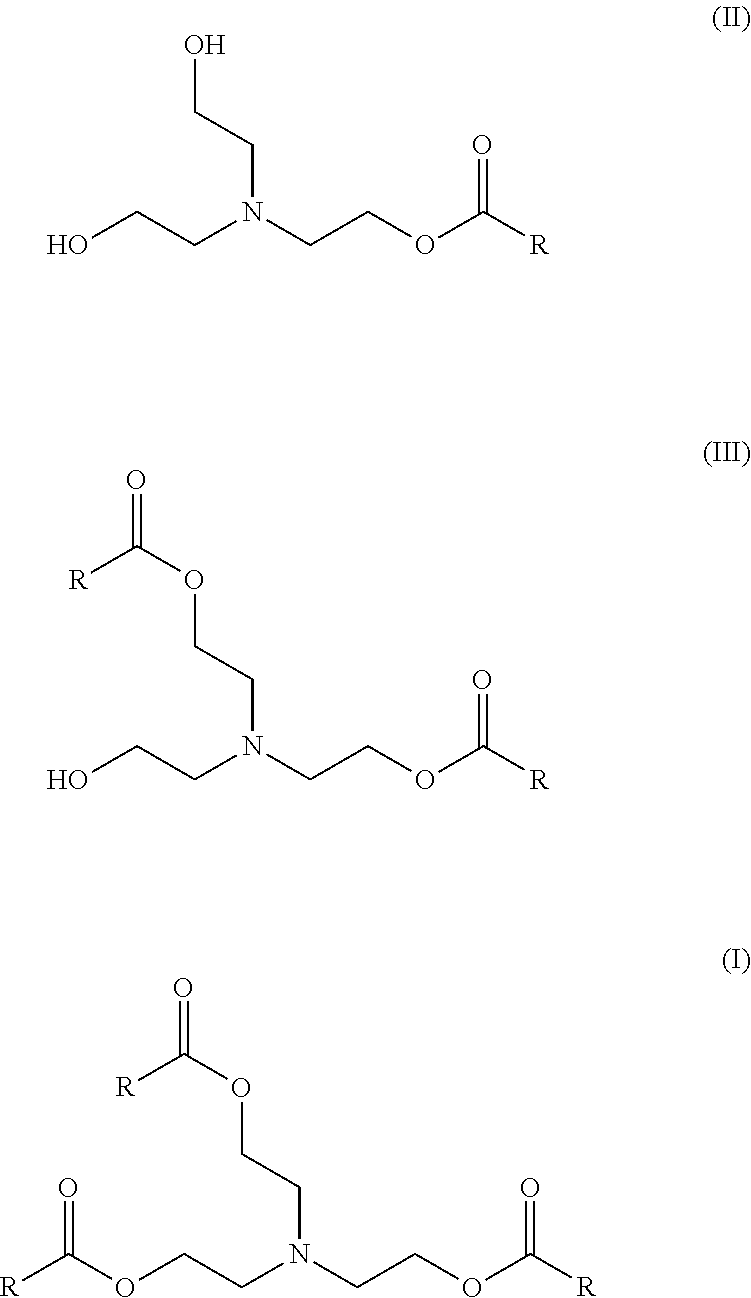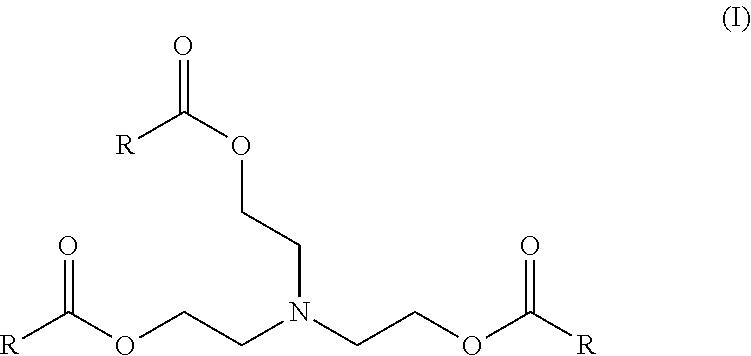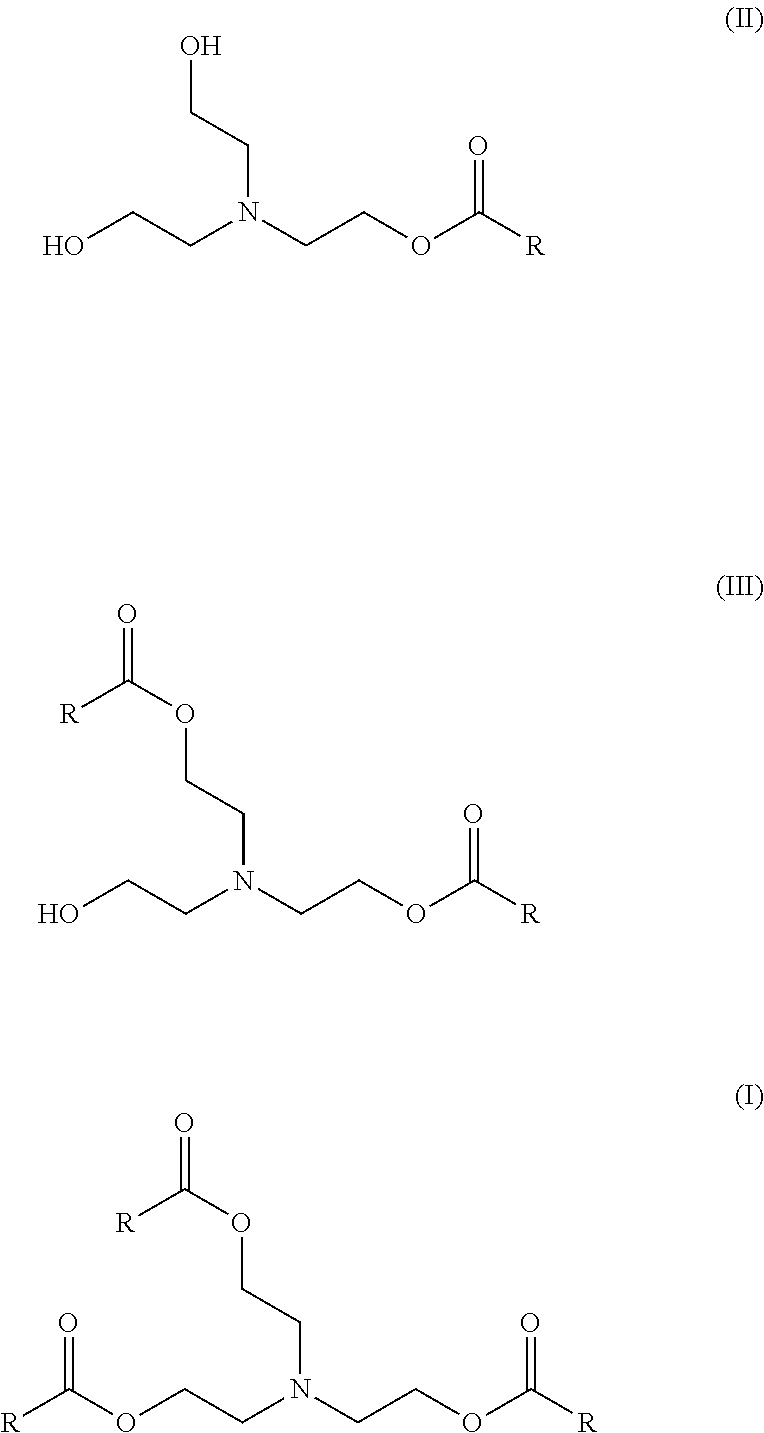Enzymatic process for producing intermediates useful as esterquat precursors
a technology of esterquat and intermediates, which is applied in the field of enzyme-based preparation of intermediates, can solve the problems of difficult formulation of esterquat, low triester quat, and reduced mono-ester and unesterified materials, and achieves greater flexibility in the formulation of corresponding fabric softening compositions and increases the triester fraction
- Summary
- Abstract
- Description
- Claims
- Application Information
AI Technical Summary
Benefits of technology
Problems solved by technology
Method used
Image
Examples
example 1
Equilibration of the Ester of Triethanolamine with Tallow Fatty Acid (1.6 Equiv) without Acid Catalyst Removal
[0064]Step 1: Conventional Acid-Catalyzed Esterification
[0065]Triethanolamine (15 g; 0.101 mol) was added to tallow fatty acid (Twin Rivers Technology; TRT-11)(43.9 g; 0.176 mol; 1.6 equiv). A 50% water solution of hypophosphorous acid (0.22 mL; 0.27 g; 0.002 equiv) was added and the mixture was heated with stirring to 140° C. with a headspace nitrogen purge to remove the generated water. After 12 h the reaction was complete and was cooled to 70° C.
[0066]Step 2: Equilibration Using Novozym® 435
[0067]Novozym® 435 (1.40 g) was added to the above mixture at 70° C. The mixture was stirred at 70° C. under a nitrogen blanket for 12 hours, and the enzyme was removed by filtration. The composition of the ester after Step 1 and Step 2 is shown below.
TABLE 3Normalized molar compositionStep 1Step 2 (enzymaticComponent(conventional)equilibration)Triethanolamine 5%10%Monoester 235%27%Die...
example 2
Equilibration of the Ester of Triethanolamine with Tallow Fatty Acid (1.5 Equiv) without Acid Catalyst Removal
[0068]This example used an identical procedure to Example 1 with triethanolamine (15 g; 0.101 mol), tallow fatty acid (Twin Rivers Technology; TRT-11)(41.2 g; 0.151 mol; 1.5 equiv), 50% hypophosphorous acid (0.22 mL; 0.27 g; 0.002 equiv), and Novozym® 435 (1.35 g). The results are shown in Table 4 below.
TABLE 4Normalized molar compositionStep 1Step 2 (enzymaticComponent(conventional)equilibration)Triethanolamine10%15%Monoester 238%30%Diester 342%38%Triester 111%17%
example 3
Equilibration of the Ester of Triethanolamine with Tallow Fatty Acid (1.75 Equivalents) without Acid Catalyst Removal
[0069]This example used an identical procedure to Example 1 with triethanolamine (15 g; 0.101 mol), tallow fatty acid (Twin Rivers Technology; TRT-11)(48.0 g; 0.176 mol; 1.75 equiv), 50% hypophosphorous acid (0.22 mL; 0.27 g; 0.002 equiv), and Novozym® 435 (1.50 g). The results are shown in Table 5 below.
TABLE 5Normalized molar compositionStep 1Step 2 (enzymaticComponent(conventional)equilibration)Triethanolamine 5% 9%Monoester 230%26%Diester 349%39%Triester 116%27%
PUM
| Property | Measurement | Unit |
|---|---|---|
| temperatures | aaaaa | aaaaa |
| temperature | aaaaa | aaaaa |
| temperature | aaaaa | aaaaa |
Abstract
Description
Claims
Application Information
 Login to View More
Login to View More - R&D
- Intellectual Property
- Life Sciences
- Materials
- Tech Scout
- Unparalleled Data Quality
- Higher Quality Content
- 60% Fewer Hallucinations
Browse by: Latest US Patents, China's latest patents, Technical Efficacy Thesaurus, Application Domain, Technology Topic, Popular Technical Reports.
© 2025 PatSnap. All rights reserved.Legal|Privacy policy|Modern Slavery Act Transparency Statement|Sitemap|About US| Contact US: help@patsnap.com



